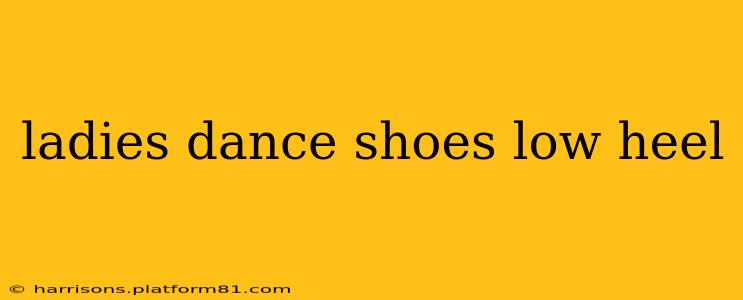Finding the perfect pair of dance shoes can be a challenge, especially when you're looking for a low heel that balances comfort, style, and support. Whether you're a seasoned dancer or just starting out, choosing the right shoes is crucial for both performance and preventing injuries. This guide explores the world of low-heeled ladies' dance shoes, addressing common questions and offering expert advice to help you find your perfect fit.
What are the Different Types of Low Heel Dance Shoes for Ladies?
The market offers a variety of low-heeled dance shoes designed for different dance styles. Understanding these differences is key to selecting the right shoe for your needs.
-
Latin Dance Shoes (Low Heel): Often featuring a slightly higher heel than other low-heel options (around 1-1.5 inches), these shoes provide a bit more lift for elegant moves and turns, particularly in styles like cha-cha, rumba, and samba. They typically have a closed toe and are made from suede or leather for grip on the dance floor.
-
Ballroom Dance Shoes (Low Heel): Ballroom dance styles like waltz and foxtrot often utilize low-heeled shoes for comfort and stability. These shoes tend to have a closed toe and can range in heel height from a very low wedge to a slightly higher, but still considered “low,” heel (around 1 inch). They often prioritize comfort and support for long periods of dancing.
-
Salsa Dance Shoes (Low Heel): Salsa dancing requires quick movements and spins. Low-heeled salsa shoes often have a slightly flared heel for better balance and stability during fast-paced steps. Suede soles are preferred for maximum grip.
-
Practice Shoes: These are designed for comfort and extended periods of practice. They might have a completely flat sole or a very low, barely-there heel. They are often more affordable and durable than performance shoes.
What Heel Height is Considered "Low" in Ladies' Dance Shoes?
The definition of "low heel" can be subjective, but generally, anything under 2 inches is considered low in the context of dance shoes. Many dancers prefer heels in the 1-inch to 1.5-inch range for a balance of style and comfort. Anything lower than that could be considered a flat or very low heel.
Are Low Heel Dance Shoes Good for Beginners?
Yes, low-heeled dance shoes are often recommended for beginners. The lower heel provides better balance and stability, making it easier to learn the fundamental steps without the added challenge of a higher heel. As your skills improve, you can consider transitioning to a slightly higher heel if desired.
How Do I Choose the Right Size and Fit for My Low Heel Dance Shoes?
Finding the right fit is crucial for comfort and injury prevention. Here's what to keep in mind:
- Measure your feet: Use a Brannock device for accurate measurements. Foot size can vary throughout the day, so measure your feet both in the morning and evening.
- Try them on: Always try dance shoes on before purchasing. Walk around in them to ensure a comfortable and secure fit.
- Consider the width: Dance shoes come in different widths (narrow, medium, wide). Choose a width that fits your foot comfortably without feeling too tight or too loose.
- Check for slippage: Your foot should not slip inside the shoe, even when dancing.
What Materials are Low Heel Dance Shoes Made Of?
The materials used in dance shoes significantly impact their comfort, durability, and grip. Common materials include:
- Leather: A classic choice, leather provides comfort, durability, and breathability.
- Suede: Suede offers excellent grip on the dance floor and a luxurious feel.
- Synthetic materials: These are often more affordable than leather or suede, but may not be as breathable or durable.
By carefully considering these factors and choosing the right shoe for your dance style and skill level, you can ensure a comfortable and enjoyable dance experience. Remember that properly fitting dance shoes are an investment in your comfort and ability!
